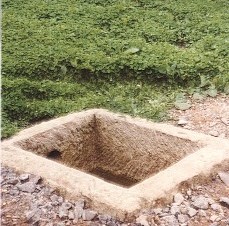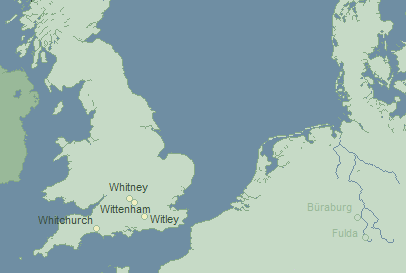
Saint Wite of Whitchurch Canonicorum
c. 801 - 842 A.D.
( Wite, Wita, Witta, Whyte, Candida, Gwen )
|
Commemoration of the Venerable Martyr Wite �  all-glorious wonder! The valiant martyr Wite, subjected to cruel ravage and slaughter at the hands of the barbarian Danes, when felled by their keen weapons surrendered her pure soul to her Bridegroom. Wherefore, she dwelleth now in paradise, where she abideth in never-waning light, and prayeth without ceasing for our salvation. O all-glorious wonder! The bones of the venerable martyr Wite thrive like the grass, as saith the prophet, and the almighty hand of the Lord maketh them known unto those who fear Him. Wherefore, beholding this, our hearts rejoice in our God, Whose good pleasure it hath been to preserve her sacred relics for us. O all-glorious wonder! Like an ever-flowing fountain the shrine of the holy Wite poureth forth grace in abundance, giving drink to those who thirst for the inexhaustible mercy of God; for He hath preserved it untouched by those who hate His saints, unto the blessing and heartening of those who honour her. Moses, Who beheld God, proclaimeth praise unto Israel, and Miriam leadeth the all-wise women. Let us all sing a hymn of victory unto God the Deliverer! Whitchurch proclaimeth praise unto Christendom, the New Israel, for thence doth the all-wise Wite, like Miriam of old, teach us to sing a hymn to God our Deliverer. Imitating the desert-dwellers of old, the venerable Wite withdrew from the world to purify her soul in solitude, seeking divine wisdom from God our Deliverer. The swords of the Danes freed Wite's soul from the body had she exhausted with ascetic feats; wherefore, having achieved victory, she singeth hymnody to God our Deliverer. (Lambertson). |
The words of this liturgy display, to some degree, a preservation of a time when Anglo-Saxon England was under attack by the Danes. It tells of a time of conversion from ancient beliefs to the ideals of Christianity.

But old pre-Christian practices were just as likely to be preserved in the policies of the expanding Church. 'Medicine, liturgy, and folklore intertwined in the literate communities of late Saxon England. This ... intertwining represents popular culture and religious practices in ... the diverse fusions of Germanic, classical, and Christian traditions ... and reflect an oral tradition of synthesis in everyday practice.' (Jolly). Both Irish and Anglo-Saxon Christianity evolved as remote modifications of the doctrine in Rome. Home-grown monks were directed to honor old practices and places of worship, by only slowly modifying the established practices of the people. Churches were built over old shrines. Pagan festivals were retained but dedicated to saints instead of the old gods. Only in this way would Christianity have been received and some degree of conversion realized.
One likely representation of this conversion of pre-Christian sites can be found on the western outskirts of the village of Morcombelake, England. Here is found the Well of Saint Whyte. At ground level, it is marked by a small, rectangular stone basin measuring about l ft x l� ft. � It is said that water from this well has the healing powers.
But it seems that this site is much older than that. Certainly old enough that very little is known about it. And it certainly is believed to by a holy site where healing occurs. This seems to point to a time of the Anglo-Saxon settlements in England. Is it a healer's well of the Pre-Christain nature? Springs were often holy sites to the early Germans. A Wite, perhaps, was a female healer.

Most of the pre-Christian sites of Anglo-Saxon times where built over by the Christian Church. Often, saint's relics where imported to these sites to begin a process of convertion. Names like Wite and Witta were encouraged to hold new meanings in an attempt to remove any relationship to the pagan past. The old religion was to be forgotten. Except for a few exceptions, the old holy wells vanished. But has the history of one remain?
It can only be surmized that the names Wite and Witta where common titles for healers and religious leaders. The Church often attached Latin alternatives that translate as 'white'. Candida and Albinus carry this meaning. It seems quite possible that this was a conscious effort to confuse the nearly identical sounding words. Clearly too, 'white' was associated with 'good'; and 'black' was associated with 'evil'. So although ties to pre-Christian beliefs were to be broken, there was a clarification that some 'good' managed to take the proper steps toward accepting the new Church.
Likewise, very little knowledge remains of the Anglo-Saxon Wittan. This Counsel of Elders was quite important to the early Anglo-Saxon people, only to alude us of any thorough understanding of its history.
So, despite the fact that the full story of Wite's Well will never be known, it does serve to show perhaps the ancient aspect of the name.
10-01-2006
� |
Harte, Jeremy. 'St Wita's well, Whitchurch Canonicorum, Dorset'. Living Spring Journal. Last retrieved on October 1, 2006: http://people.bath.ac.uk/liskmj/living-spring/journal/issue1/research/jharhpl7.htm � |
� |
Jolly, K. L. Popular Religion in Late Saxon England: Elf Charms in Context. Chapell Hill: The University of North Carolina Press. 1996. |
� |
Lambertson, I. 'Commemoration of the Venerable Martyr Wite, Anchoress of Charmouth, Wonder-worker of Dorset'. Orthodox England on the 'net. Last retrieved on October 1, 2006: http://www.orthodoxengland.btinternet.co.uk/servwite.htm � |
� |
Rattue, James. 'St Whyte's Well'. Some Wells in the South and West. Last retrieved on October 1, 2006: http://people.bath.ac.uk/liskmj/living-spring/sourcearchive/fs5/fs5jr1.htm � � |

� Home � Site Menu � Contact �

